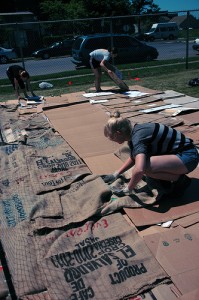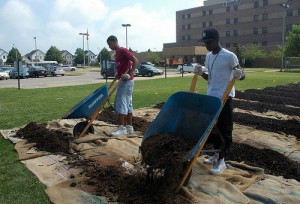 With more than 17,000 vacant properties in the City of Buffalo, one would hope we could transform a larger percentage of those lots into productive space, even if only for a few growing seasons. Other cities, like Detroit, are figuring out ways to turn formerly residential land into small farms or large gardens that grow food for their soup kitchens, congregations or the needy. The problem is that dirt you put a house on isn’t the same kind of dirt you grow tomatoes in.
With more than 17,000 vacant properties in the City of Buffalo, one would hope we could transform a larger percentage of those lots into productive space, even if only for a few growing seasons. Other cities, like Detroit, are figuring out ways to turn formerly residential land into small farms or large gardens that grow food for their soup kitchens, congregations or the needy. The problem is that dirt you put a house on isn’t the same kind of dirt you grow tomatoes in.
What are some solutions? Most urban gardeners don’t have the patience to remediate soil over several years, so we either have to dig out the dirt and replace it with truckloads of soil OR truck in lots of soil to fill raised beds. Another way is to make your own dirt.
 I’m trying a combination of strategies with The Garden of Stewardship over on East Eagle. The garden is on the property of Sheehan Health Network. It was a big fenced-in grassy area. We cannot dig into the ground because it’s a very thin layer of dirt covering an awful lot of clay. The grass/weeds are using what little dirt there is. So, I decided to smother the grass and build our soil on top of it. I am calling the strategy, the Urban Café Gardening Method to acknowledge the fact that all the materials we’ll use are found readily in cities–cities with coffee drinkers anyway! Here’s how you can replicate it in your space.
I’m trying a combination of strategies with The Garden of Stewardship over on East Eagle. The garden is on the property of Sheehan Health Network. It was a big fenced-in grassy area. We cannot dig into the ground because it’s a very thin layer of dirt covering an awful lot of clay. The grass/weeds are using what little dirt there is. So, I decided to smother the grass and build our soil on top of it. I am calling the strategy, the Urban Café Gardening Method to acknowledge the fact that all the materials we’ll use are found readily in cities–cities with coffee drinkers anyway! Here’s how you can replicate it in your space.
1) Laying Cardboard–you’ll need lots and lots of cardboard. Get in tight with the produce guys at your supermarket or else–dumpster dive! Bake pineapple upside down cake for all your friends with trucks (Kevin, I owe you a cheesecake). Do a little sorting of your cardboard to make sure the smaller pieces go down on the ground first. Use your larger pieces of cardboard to cover both the gaps and smaller pieces. Trust me, there’s no such thing as too much cardboard. It is eventually going to break down, but the longer it takes–the better. You want to make sure no grass is peeking out from the edges. Any grass that sees the light of day, won’t die. Smother and kill the grass/weeds.
2) Weaving Coffee Bags–Our coffee bags are from a local roaster, McCullagh Coffee on Swan St. We’re glad McCullagh has a heart for the environment. They usually leave a pallet of empty bags near their facility which you can pick from. We’ve used 1,000 bags so far (they go through 100 a day). If we weren’t using these bags, they might end up in the landfill. The bean bags are shipped from South America and are made of jute, which is a super strong fiber. Essentially, we’re using the bags like you would a landscape fabric. I lay the bags in a special pattern to minimize shifting.
3) Marking the Rows–We measured out the rows like anyone else would. (In hindsight, I would extend them to match the length of my soaker hose more closely. Hoses seem to come in 25 or 50 foot lengths). We are using compost made locally from the veggie waste of Lexington Coop and eateries. It’s been mixed with a little manure, bagged leaves and shredded tree. Because this compost was very coarse we have to sift it. We took advantage of the large wood chunks and sticks by laying them down to mark the rows. The sticks will break down fastest at the bottom of the row.
took advantage of the large wood chunks and sticks by laying them down to mark the rows. The sticks will break down fastest at the bottom of the row.
4)Mixing and Building Rows–We mixed our compost with vermiculite and peat moss according to Mel Bartholomew’s method. This will help the rows retain moisture and keep the soil loose/light enough for the roots to move as they wish. You should avoid stepping/leaning in your growing area because it compresses the soil. We put a topcoat of the plain compost on top of the mixed layer.
5)Winterizing--Stay tuned because at the end of the season we’ll plant some green manure and I’m even planning a DUNG-US Day where (I hope) you all will come out and help us spread manure over the rows, beds and mounds so they’ll be even more fertile next growing season!
Funding for The Garden of Stewardship is provided through a start-up grant under WNED’s Think Bright & Well/LiveWell Program (which is funded by The John R. Oishei Foundation, Corporation for Public Broadcasting and Independent Health). If you would like to volunteer or learn more about the garden, please email cseawell@wned.org
